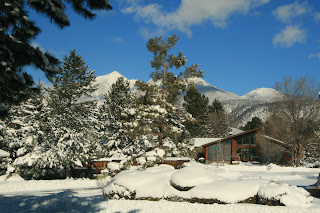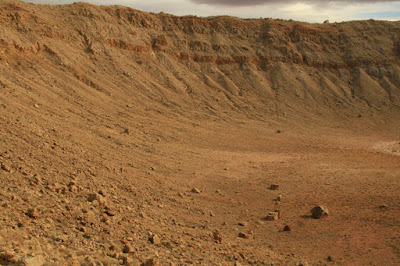The
2010 Moab River Rendezvous was held under sparkling sunny skies from November 11 to 14 and featured a one-day float trip on the Colorado River, numerous lectures and films, and a gathering of scientists and river enthusiasts. I was honored to be the
Keynote Speaker on Saturday, Nov. 13, with "Carving Grand Canyon". This lecture was very well received and has been revamped to include the latest findings on how the Grand Canyon formed. Pictures of a lecture are not that exciting but look below to see how the river trip worked out!
(You can also read about and see photo's from my posting on the 2009 Moab River Rendezvous
here).

The trip took place on Friday, Nov. 12 and put-in at the Hittle Bottom ramp near the Fisher Towers. One of the highlights of the Rendezvous was the participation of three historic replica boats from the 1950's. Here the Flavell and the GEM (replicas) take to the water at the put-in.

Gus Scott and Richard Quartaroli stand in front of the Flavell before she was launched on her maiden voyage

One of the highlights of the trip for me was seeing geologist Peter Winn again after nearly 18 years. On my very first Grand Canyon river trip in 1976, Peter was an ARTA boatman who shared a story about transgressing Cambrian seas. I remember the proverbial "light-bulb" going on for me at that moment and knew that geology was what I wanted to pursue after hearing his stories from the rocks.

Myself with Peter Winn at the lunch stop

A picture of me with Bill Bishop, a colleague from our days as boatmen with Worldwide Explorations

Here is a shot of the two main organizers of the event - geologist Tamsin McCormick and Director Michael Smith of
Plateau Restoration. PR does great work rehabilitating beaches from exotic plant invasions and placing students in conservation positions and careers. They are the main sponsors of the River Rendezvous. Board member Leif Johnson looks on from behind.

River historian Roy Webb (University of Utah) looks at a piece of driftwood on the lunch beach. But this is not just any old piece of driftwood - it is a piece from the old Dewey Bridge upstream on the river. In April, 2008, the bridge caught fire and was destroyed. You can read about this historic loss
here.

Michael Smith examines some of the hardware that was used to identified this historic piece of driftwood. He proposes to raft this piece of history back to town where it can be preserved as a part of Moab area history.

Now for the geology part! I took this picture from the boat beach which shows rounded river boulders resting on an outcrop of the Cutler Formation. Across the Colorado River and far in the distance are the Fisher Towers, fantastically eroded monoliths cut into the same formation.

The La Sal Mountain laccolith received a dusting of fresh snow just a few days before the Rendezvous began. These spectacular mountains provide much of the scenic charm found everywhere in the Moab area. They formed when magma spread laterally within sedimentary layers and cooled into a dense rock called trachyte. This all happened between 28 and 22 Ma. Relatively recent erosion has removed the once-enclosing sedimentary rocks and left the intrusive rocks in these peaks. Not visible from this angle is Mt. Peale, the highest point in the range and considered the highest point on the entire Colorado Plateau at 12,726 ft. (it barely beats out Mt. Humphrey's on the San Francisco Peaks at 12, 633). To read more about laccoliths see my previous postings on the
Henry Mountains and
other Plateau laccoliths.

Fantastic outcrops of Triassic rocks near Castleton Tower. Aprons below consist of the Moenkopi and Chinle formations, The towers are cut into the Wingate Sandstone. To see photo's of Castleton Tower from the open doors of a helicopter
look here!

Eroded rills in the Moenkopi Formation along the Colorado River near Moab

The trees were still showing gold in Moab at this late date. All of the fall colors out west are a little later than normal this year.

Jason Hughes takes the oars of the GEM while boat builder and river historian Tom Martin looks on (left) with his wife Hazel (right). The 2010 Moab River Rendezvous was a great success. Plan on attending it in 2011!




















































